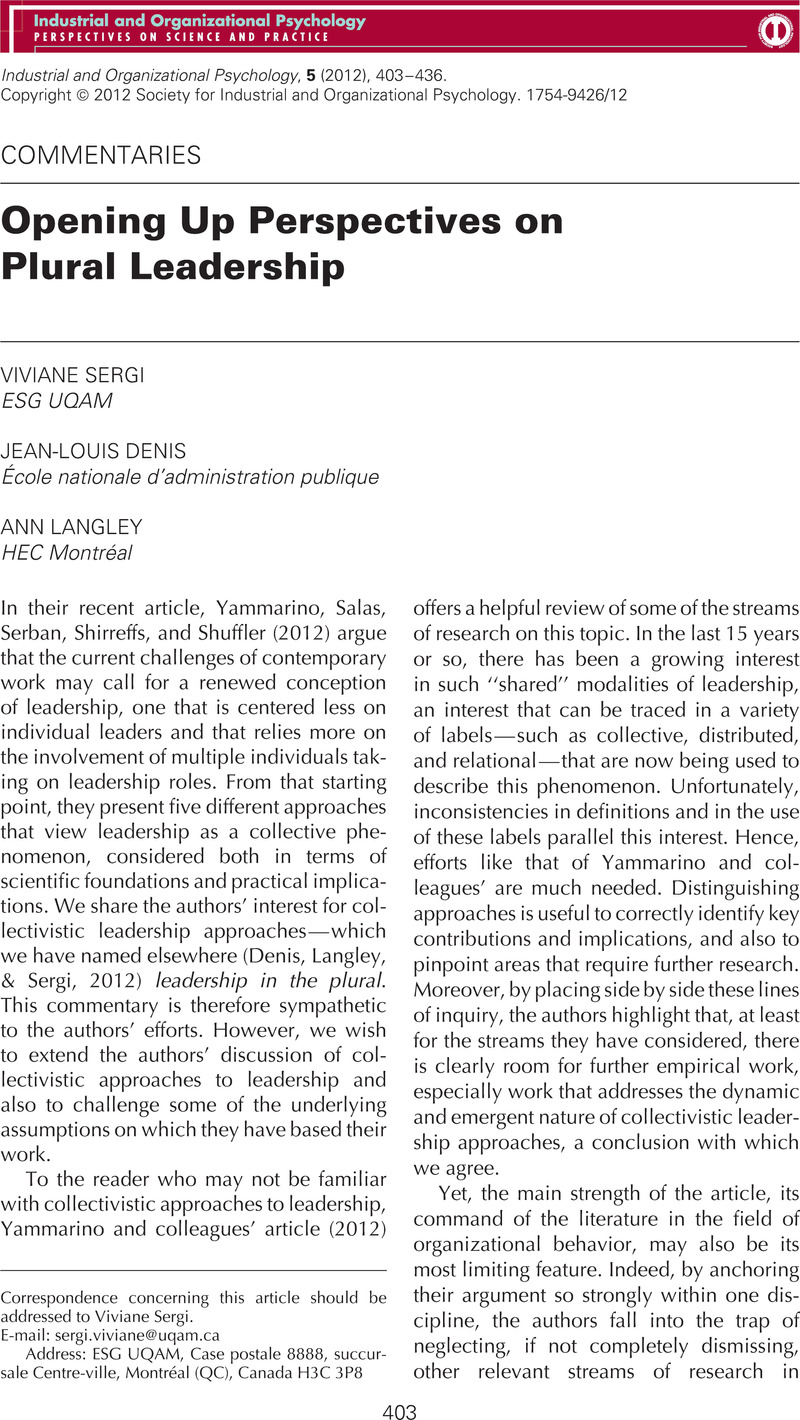Crossref Citations
This article has been cited by the following publications. This list is generated based on data provided by Crossref.
Shuffler, Marissa L.
Salas, Eduardo
Yammarino, Francis J.
Serban, Andra
and
Shirreffs, Kristie
2012.
Putting the “We” in Leadership: Continuing the Dialogue to Advance Our Science and Practice.
Industrial and Organizational Psychology,
Vol. 5,
Issue. 4,
p.
437.
Gronn, Peter
2015.
The view from inside leadership configurations.
Human Relations,
Vol. 68,
Issue. 4,
p.
545.
Quick, Kathryn S
2017.
Locating and building collective leadership and impact.
Leadership,
Vol. 13,
Issue. 4,
p.
445.
Côté-Boileau, Élizabeth
Denis, Jean-Louis
Callery, Bill
and
Sabean, Meghan
2019.
The unpredictable journeys of spreading, sustaining and scaling healthcare innovations: a scoping review.
Health Research Policy and Systems,
Vol. 17,
Issue. 1,
Kang, Seungmin
and
Svensson, Per G.
2019.
Shared leadership in sport for development and peace: A conceptual framework of antecedents and outcomes.
Sport Management Review,
Vol. 22,
Issue. 4,
p.
464.
Endres, Sigrid
and
Weibler, Jürgen
2020.
Understanding (non)leadership phenomena in collaborative interorganizational networks and advancing shared leadership theory: an interpretive grounded theory study.
Business Research,
Vol. 13,
Issue. 1,
p.
275.
Van De Mieroop, Dorien
2020.
A deontic perspective on the collaborative, multimodal accomplishment of leadership.
Leadership,
Vol. 16,
Issue. 5,
p.
592.
Empson, Laura
2020.
Ambiguous authority and hidden hierarchy: Collective leadership in an elite professional service firm.
Leadership,
Vol. 16,
Issue. 1,
p.
62.
Fairhurst, Gail T
Jackson, Brad
Foldy, Erica Gabrielle
and
Ospina, Sonia M
2020.
Studying collective leadership: The road ahead.
Human Relations,
Vol. 73,
Issue. 4,
p.
598.
Fox, Stephanie
and
Comeau-Vallée, Mariline
2020.
The negotiation of sharing leadership in the context of professional hierarchy: Interactions on interprofessional teams.
Leadership,
Vol. 16,
Issue. 5,
p.
568.
McCauley, Cynthia D.
and
Palus, Charles J.
2020.
Developing the theory and practice of leadership development: A relational view.
The Leadership Quarterly,
p.
101456.
Docherty, Kristy
2021.
Processual Perspectives on the Co-Production Turn in Public Sector Organizations.
p.
130.
Côté-Boileau, Élizabeth
Breton, Mylaine
and
Denis, Jean-Louis
2021.
Control rooms in publicly-funded health systems: Reviving value in healthcare governance.
Health Policy,
Vol. 125,
Issue. 6,
p.
768.
Souza, Renato
Wood, Thomaz
and
Jackson, Brad
2021.
Reimagining Leadership on the Commons: Shifting the Paradigm for a More Ethical, Equitable, and Just World.
p.
119.
Souza, Renato
and
Wood Jr, Thomaz
2022.
THE MULTIPLE LENSES OF STUDYING AND APPROACHING LEADERSHIP.
Revista de Administração de Empresas,
Vol. 62,
Issue. 6,
Souza, Renato
and
Wood Jr, Thomaz
2022.
MÚLTIPLAS LENTES DE ESTUDO E ABORDAGEM DA LIDERANÇA.
Revista de Administração de Empresas,
Vol. 62,
Issue. 6,
Geuijen, Karin
Hartley, Jean
Fuglsang, Lars
and
Rønning, Rolf
2022.
Valuing Public Innovation.
p.
223.
Côté-Boileau, Élizabeth
Breton, Mylaine
Rouleau, Linda
and
Denis, Jean-Louis
2022.
Appropriating integrated performance management tools in healthcare: a sociomaterial work story.
Journal of Health Organization and Management,
Vol. 36,
Issue. 4,
p.
397.
Foldy, Erica Gabrielle
and
Ospina, Sonia M.
2023.
‘Contestation, negotiation, and resolution’: The relationship between power and collective leadership.
International Journal of Management Reviews,
Vol. 25,
Issue. 3,
p.
546.
Gabriel, Lucie
Saint-Michel, Sarah E.
and
Hennequin, Emilie
2024.
Let it go, let it go? Implementing shared leadership in an F-form company.
Revue de gestion des ressources humaines,
Vol. N° 130,
Issue. 4,
p.
3.





